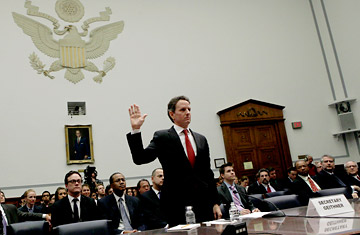
Treasury Secretary Timothy Geithner is sworn in prior to testifying before the House Oversight and Government Reform Committee on Jan. 27, 2010
(2 of 2)
"The idea that you had to come to some unified settlement with all of the banks was ridiculous," says Thomas Adams, a lawyer at Paykin Krieg and Adams, LLP, and a former managing director at bond insurer FGIC. "But that seems to be the working logic at the Federal Reserve."
The BlackRock report said that five of the six biggest creditors of AIG's financial-products division would have been willing to end the contracts for less than face value. French bank Société Générale, which was AIG's largest CDS counterparty, for instance, according to Blackrock was willing to unwind the bond insurance its had bought from AIG on its lowest quality bonds for 90 cents on the dollar, or for 10% less than what AIG had originally promised to pay. About 30% of the $16.4 billion in CDS contracts that SocGen had bought from AIG were on bonds rated BBB or worse. A 10% discount on those contracts would have saved AIG $475 million.
Other banks were willing to strike even more generous deals. UBS initially told AIG that it would take collateral worth 35% less than what the insurer owned on 55% of the $4.3 billion in CDS contracts it had sold to the Swiss bank. For the remaining 45%, UBS was willing to allow AIG to pay 10% less than what it had originally promised. Those deals would have saved AIG about $1 billion. AIG later broke off those negotiations, and as with all of its other counterparties, paid UBS in full. BlackRock, in the report, said Goldman Sachs, French bank Calyon and German financial giant Deutsche Bank were also willing to strike deals.
BlackRock, though, stressed that it is unlikely that any of those banks would have been willing to make a "deep concession" on price. Nor is it clear that all of the deals, including those with SocGen or UBS, could have been completed. French regulators pressured SocGen and Calyon not to negotiate with AIG. What's more, BlackRock said that investment bank Merrill Lynch, which had recently agreed to be purchased by Bank of America, was not willing to strike a deal. If AIG had then paid off only Merrill's bond insurance in full, the other banks may have balked on their less-than-full deals.
What's more, the deals the banks wanted to strike with AIG would have involved the insurer and the government giving up their right to reclaim the underlying bonds. Some have argued that would have led to a worse deal for AIG. Instead, the Federal Reserve decided to give AIG the money to pay off the CDS contracts in exchange for the soured bonds. As credit markets have rebounded, those investments, most of which were risky mortgage bonds, have risen in value.
But it's still questionable that the Federal Reserve saved taxpayers money by paying off Goldman and others in exchange for the bonds. The government gave AIG $29.6 billion to pay off the rest of its CDS contracts, acquiring the bonds in the process. Those bonds are now worth $23.5 billion. Either way, Uncle Sam winds up in the red.
"It is very clear that the New York Fed was preoccupied with looking out for the interests of Wall Street at the expense of Main Street," says California Congressman Darrell Issa, a Republican, who questioned Geithner and others on Wednesday. "Given the circumstances and the fact that they were dealing with taxpayer dollars, the Fed had an obligation to try and secure the best deal possible for the taxpayers and instead brokered a deal that helped the rich get richer and then tried to cover it up."
